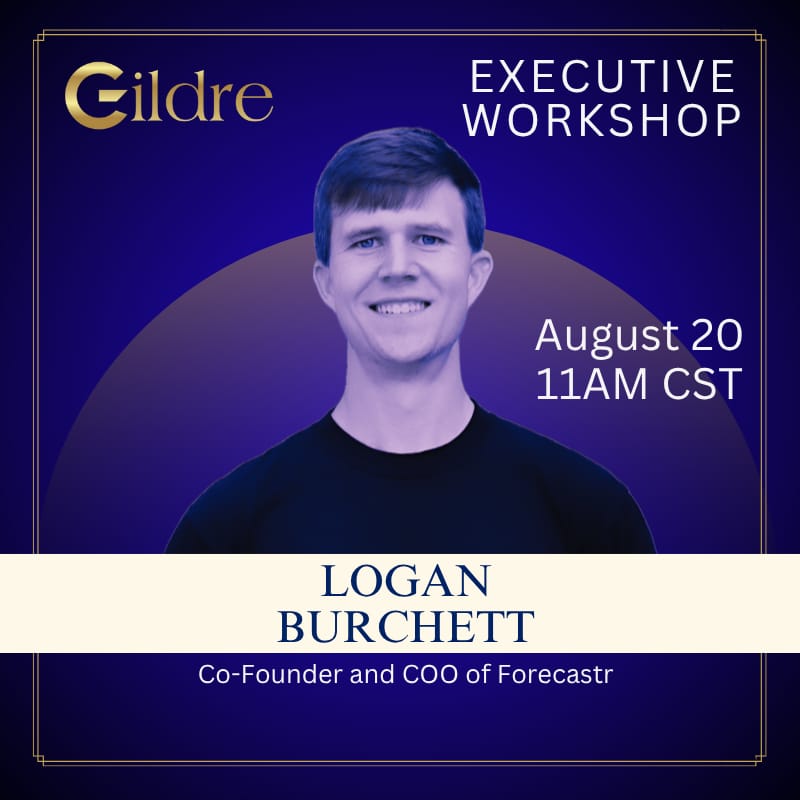- Gildre Founders Newsletter
- Posts
- Welcome to the Gildre August 2025 Newsletter - Which Financial Metrics Should I be Tracking?
Welcome to the Gildre August 2025 Newsletter - Which Financial Metrics Should I be Tracking?
Entrepreneurs! This month at Gildre, we’re diving deep into
Founder Runway and Financials Metrics.
2025 is shaping a new kind of founder.
Less hype, more clarity. Less dilution, more control.
The founders winning today are mastering capital like operators.
This is what they’re doing differently—and why you should, too.
Join our August Executive Workshop: Cash Flow Survival Kit & Financial Essentials with Logan Burchett, Co-Founder at Forecastr, on Wednesday, August 20th. Logan brings deep expertise in financial modeling and cash flow optimization, having helped countless startups navigate their most challenging financial periods and emerge stronger.
RSVP for the event here: https://lu.ma/c3f4wi3m

There's no room for improvisation
What has changed since 2021?
The "grow at all costs" mentality of 2021-2022 is dead. With cautious VCs and longer fundraising cycles (12+ months), financial discipline is now survival.

The financial landscape for founders in 2025 and beyond is shaped by evolving funding trends, a continued focus on AI and deep tech, and a more cautious but potentially recovering venture capital market. Extending runway and achieving financial sustainability are paramount.
Here's how you'll optimize runway and financials from 2025 onwards:
I. Strategic Financial Planning & Management:
Deep Dive into Cash Flow & Burn Rate:
What to do? Regularly calculate your burn rate (monthly spending) and understand every dollar going in and out.
Tendency: Understand and analyze your spending to make informed financial decisions.
Conservative Expense Projections & Aggressive Cost Cutting:
What to do? Overestimate expenses, underestimate revenue, and eliminate non-essential spending.
Tendency: Cut non-essential SaaS tools and marketing spend before headcount
Scenario Planning:
What to do? Create multiple financial forecasts (best-case, worst-case, likely) to prepare for various market conditions and unexpected events.
Tendency: Anticipate challenges and opportunities, rather than reactive.
Early Focus on Profitability Milestones:
What to do? Focus on clear revenue paths and early profitability, even if partial. Diversify income streams
Tendency: Shift from a "growth at all costs" mentality to a "sustainable growth" approach.

Optimize Pricing Strategy:
What to do? Continuously analyze and adjust pricing, experimenting with tiered, value-based, and bundled plans, to reflect product/service value.
Tendency: Pricing is a powerful lever for increasing revenue without additional expenses.
Extend Runway through Strategic Capital Management:
What to do? Target a 24-36 month cash buffer, as fundraising can take over a year. Invest idle cash securely in treasury bills or money market funds for higher yields.
Tendency: Build a significant financial cushion to weather market fluctuations and fundraising delays.
II. Adapting to Funding Landscape & Opportunities:
Understand Current Funding Trends:
What to do? Stay informed on global funding trends.
Mid-2025: AI leads global funding, with cybersecurity and fintech also strong.Tendency: Align your business model and pitching to current investor interests and valuations.
Target Strategic M&A and Exit Opportunities:
What to do? Be aware that M&A activity for venture-backed companies is surging. This could be a viable exit or growth strategy.
Tendency: Consider strategic partnerships or acquisition targets that can bolster your resources or market reach.
Be Prepared for Increased Scrutiny from Investors:
What to do? Have impeccable financial statements, clear KPIs, and a well-articulated growth plan.
Tendency: Transparency and data-driven decision-making will be key to attracting investment.
2025 Context: the VC market recovers, but remains cautious compared to 2021 highs.
III. Operational Efficiencies & Resource Optimization:
Outsourcing Strategic Functions:
What to do? Outsource non-core functions like MVP and software development, customer support, or marketing to specialists in cost-effective regions.
Tendency: Leverage external expertise to reduce fixed overhead and gain flexibility in scaling operations.
2025 Context: High in-house costs can quickly deplete runway. Outsourcing offers access to skilled talent at a fraction of the cost.
Let me show you exactly how one founder turned these principles into growth without giving up a single share of equity.

Doe Lashes (USA)
Founder: Jason Wong
Industry: E-commerce (premium reusable lashes)
The Problem
Jason had a profitable brand with strong traction, but:
He didn’t want to give up equity so early.
He needed fast capital to scale inventory and ads.
He wasn’t big enough yet to raise an attractive VC round.
The Solution
Instead of going to traditional VCs, Jason used Clearco (formerly Clearbanc), a non-dilutive financing platform. Clearco analyzed his real-time Shopify sales, ad performance, CAC, and LTV.
They offered him $100,000 USD in under a week.
No equity taken
No personal guarantees
How It Worked
He used the money to stock inventory and boost paid marketing.
Instead of fixed interest, Jason repaid Clearco via a % of his daily sales (e.g., 5%).
Selling more = faster payback
Selling less = slower payback
No pressure, no rigid terms
The Outcome
He multiplied revenue and kept 100% ownership of his company.
He didn’t have to pitch investors—he just showed solid data.
When the time came, he raised VC later on—but at a better valuation, on his terms.
Why This Matters in 2025
Founders are prioritizing flexibility and a longer runway without giving up control.
Platforms like Clearco, Wayflyer, and Capchase make that possible—
Based on real data, not just a pitch deck
Without dilution or bureaucracy
Final Thoughts
With VC funding tighter than ever, smart founders are building funding stacks that mix grants, revenue-based financing, venture debt, and timed equity.
Like Jason Wong at Doe Lashes, they’re unlocking growth without giving up control—buying time, extending runway, and raising on their terms.
This isn’t anti-VC. It’s pro-leverage.
The founders who get this?
They’re not chasing capital. They’re choosing it.
Your time and capital are precious. Gildre helps you make smarter decisions, faster—by learning from people who've already been there.
If you’re interested in learning more about the Gildre Community you can schedule a conversation with Managing Partner, Taiga Gamell here.
Cheers,
Eliana
